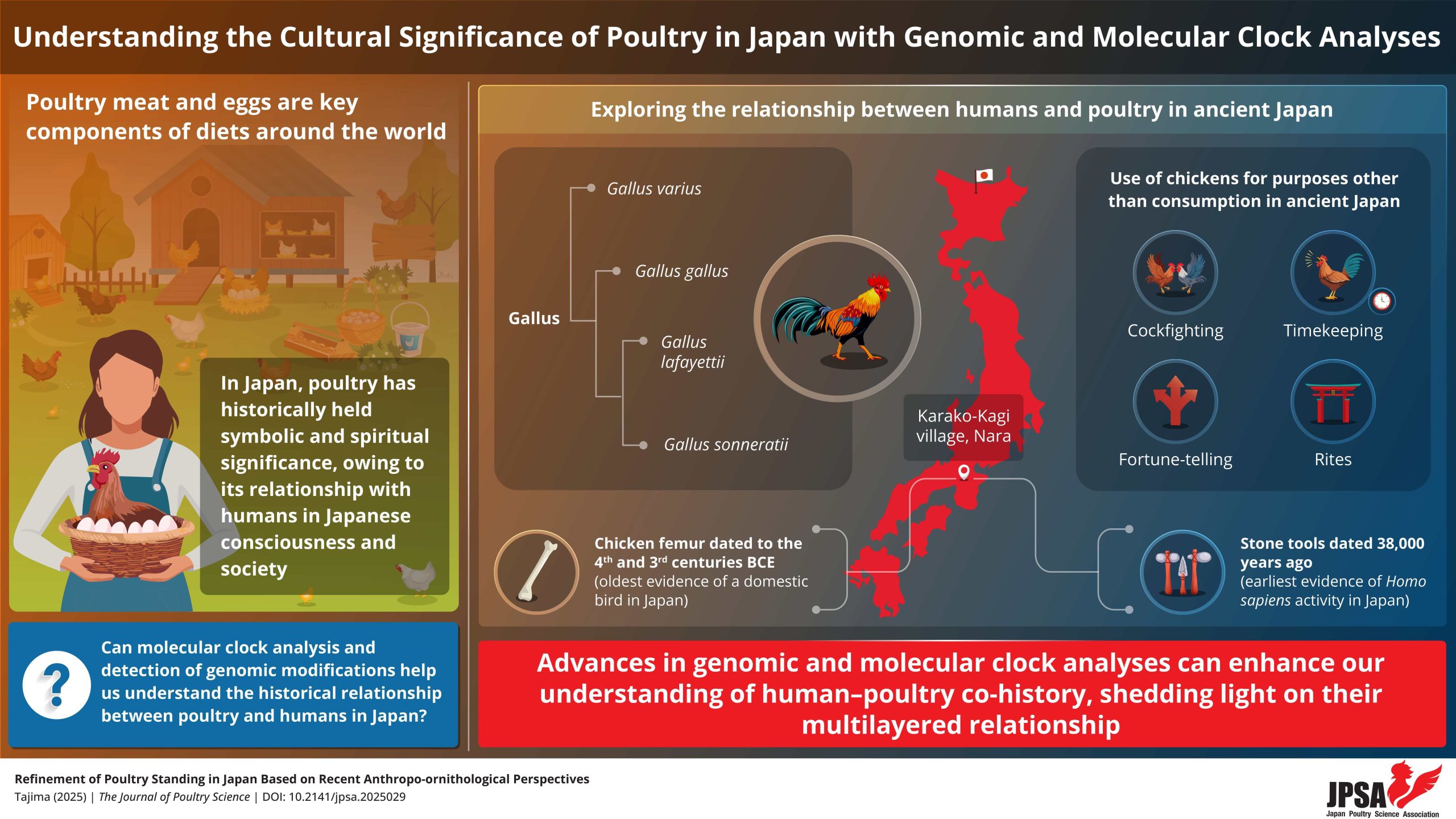2025.11.10
RESEARCH NEWS STORY
Examining the Cultural Significance of Poultry in Japan Using Genetic and Anthropological Data
Review examines how recent genetic and anthropological data can help understand the cultural significance of human–poultry relationship in Japan
While poultry is globally considered a prime source of protein, it is deeply embedded in Japanese society as a cultural icon. A new review study explains how recent genetic and molecular analyses can inform our understanding of the unique historical bond between humans and poultry. A combination of anthropological and ornithological perspectives can create a refined historical blueprint, helping decode how poultry came to possess cultural and spiritual significance in Japanese society.
Image title: Examining the Cultural Significance of Chicken in Japan from Ornithological and Anthropological Perspectives
Image caption:Recent genetic research may help refine our understanding of the human–poultry relationship in Japan
Image credit: Professor Emeritus Atsushi Tajima from the University of Tsukuba, Japan
License type: Original content
Usage restrictions: Cannot be used without permission
Poultry is an important source of high-quality protein in diets across the globe. In Japan, the relationship between chickens and humans goes beyond dietary needs. Historically, poultry has held strong cultural significance in the country and is widely considered a symbolic or spiritual entity by its people.
A review published online in Volume 62 of The Journal of Poultry Science on September 25, 2025, examines how recent advancements in genomic and molecular clock analyses can refine our understanding of the unique relationship between humans and chickens in Japan. The study was conducted by Professor Emeritus Atsushi Tajima, University of Tsukuba, Japan. Beyond an evolutionary perspective, the review explores this multilayered relationship by examining the anthropological, ornithological, ritualistic, mythic, and artistic aspects of Japanese society.
“Current evidence indicates that chickens first appeared in Japan during the Yayoi period, approximately 2,000 years ago, coinciding with a period of active human migration to the Japanese archipelago. Since then, poultry has played notable roles in Japanese art, literature, mythology, and folktales,” explains Prof. Tajima.
From an evolutionary perspective, birds are believed to have evolved from theropod dinosaurs that survived the Cretaceous–Paleogene boundary mass extinction event. Molecular and genomic analyses have revealed that the domestic chicken is a descendant of the red junglefowl. However, it possesses genes derived from several junglefowl species, indicating interbreeding among several ancestral species.
“The red junglefowl (Gallus gallus) is generally considered to be the major ancestor of the domestic chicken. However, based on mitochondrial DNA sequences, a strong indication of interspecies hybridization has been observed between the grey junglefowl and red junglefowl, and between the grey junglefowl and the Ceylon junglefowl,” says Prof. Tajima.
In Japan, animals can be designated as “cultural assets”—a status that grants them legal protection. There are numerous indigenous chicken breeds in Japan, 17 of which are designated as natural monuments and enjoy special protection under the “Law for the Protection of Cultural Properties.” Recent mitochondrial DNA analyses have revealed that native chickens have diverse origins, indicating that their ancestors were first introduced in distinct geographical regions in Japan.
“Chickens with diverse genetic backgrounds were introduced across various geographical regions in Japan, where they were selected according to region-specific criteria,” explains Prof. Tajima. “Exploring the roles of poultry incorporated into regional historical events or monuments, based on a combination of anthropological and ornithological evidence, is valuable for a deeper understanding of cultural heritage in Japan,” he explains further.
From a cultural perspective, chickens were used for cockfighting, fortune-telling, timekeeping, and rites in ancient times, rather than being used for food consumption, indicating their symbolic significance in Japan. Along with analyzing how various chicken breeds evolved, an analysis of human societies in Japan is also critical for understanding how chickens came to be deeply embedded in Japanese consciousness and society. Therefore, the review examines anthropological data from the time humans first appeared in Japan.
“The earliest evidence of Homo sapiens activity in the Japanese archipelago consists of stone tools dated to approximately 38,000 years ago,” notes Prof. Tajima. The stone tools have been excavated from the Ishinomoto site in Kagoshima Prefecture. Additionally, archaeological evidence suggests the management of agriculture by humans in Japan around 7,000 years ago.
Overall, in the Japanese context, considering chicken merely as a protein source is significantly shortsighted. This review demonstrates that anthropological and ornithological data, especially recent genomic data, can help improve our understanding of the unique bond between humans and chickens in the country.
Reference
| Title of original paper: | Refinement of Poultry Standing in Japan Based on Recent Anthropo-Ornithological Perspectives |
|---|---|
| Journal: | The Journal of Poultry Science |
| DOI |
Additional information for EurekAlert
| Latest Article Publication Date: | 25 September 2025 |
|---|---|
| Subject of Research: | Literature review |
| Subject of Research: | Animals |
| Conflicts of Interest Statement: | The authors declare no conflicts of interest. |
About University of Tsukuba in Japan
The University of Tsukuba is located in Tsukuba, Ibaraki, Japan. The university consists of 28 college clusters and schools. The university has been continuously contributing to the fields of science and culture, along with the intention to cultivate men and women with intelligence and rich human qualities. The university strives to develop an organization better suited the functions and administration with a new concept of education and research highly international in character, rich in diversity, and capable of dealing sensitively with the changes occurring in contemporary society.
Website: https://www.tsukuba.ac.jp/en/
About Professor Emeritus Atsushi Tajima from the University of Tsukuba, Japan
Dr. Atsushi Tajima is currently a Professor Emeritus at the University of Tsukuba, Japan. He has published more than 100 articles, with over 2,000 citations. His major research interests include conservation of poultry genetics resources using germline chimera technology and historical analysis of the development of agricultural universities in Japan. He is a recipient of the Japan Poultry Science Association Award and the Education Award from the Japan University Farm Consortium.
Funding information
Not applicable
Media Contact
Kazuhisa Honda
E-mail: honda@tiger.kobe-u.ac.jp
Web: https://jpn-psa.jp/en/home-en/


